
Skeletons & Skulls
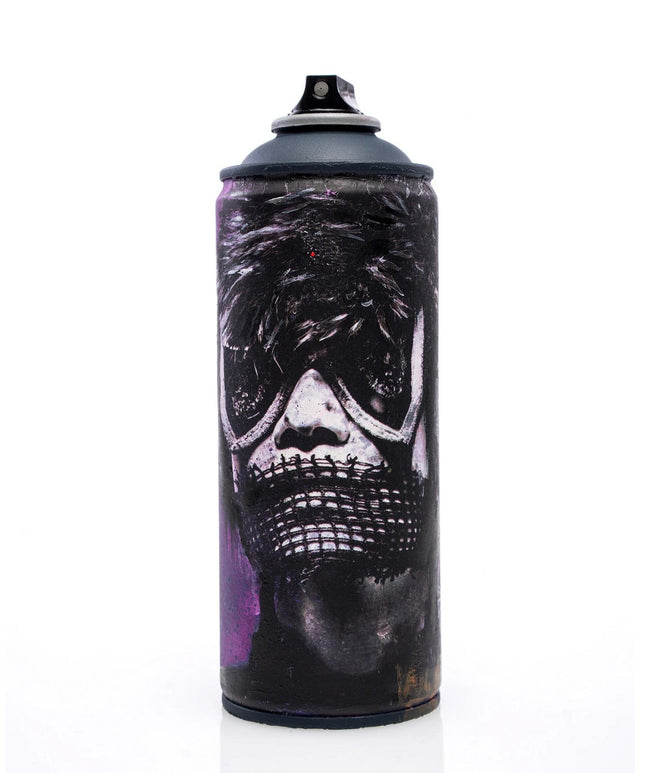
Eddie Colla Salvage Can 11 Original Spray Paint Can Sculpture Painting Eddie Colla
Salvage Can 11 Original Painting on Spray Paint Can Mixed Media Sculpture Artwork by street artist graffiti legend Eddie Colla. 2018 Signed Original Spray Paint Acrylic Mixed Media on Spray Paint Can Artwork Size 3x8 "I made this series of cans in China in 2018. I had been waiting for supplies to start working on larger pieces. The residency where I was had kept all their empty spray cans. I started making these small pieces from the used spray cans. It wasn't anything I planned; I just had an unexpected amount of free time waiting for my materials to arrive, so I worked with what was available. Each can is signed and dated on the bottom of the can." -Eddie Colla Eddie Colla's Innovation in Street Art Eddie Colla's "Salvage Can 11" stands as a powerful statement within the realm of street pop art and graffiti artwork, an original painting on a spray paint can that marries mixed media techniques with the subversive energy of street art. The work is part of a series created in 2018 during a residency in China, a period that Colla describes as marked by an unexpected hiatus, waiting for art supplies, which led to the innovative use of discarded materials to create something unforeseen yet profound. Colla's "Salvage Can 11" is a testament to the spontaneous and adaptive spirit that often drives street art. Faced with a delay in his usual creative process, Colla turned to the empty spray cans available at his residency, transforming them from tools into canvases. This act of reclamation gave new life to the used cans and challenged the perception of value and utility in art materials. The resulting artwork—a signed original piece—is a mixed-media sculpture that encapsulates the essence of graffiti artwork: raw, immediate, and deeply personal. Visual Dynamics of "Salvage Can 11" The visual impact of "Salvage Can 11" is immediate and visceral. The imagery on the can is haunting, with the figure's features suggesting a blend of humanity and mask-like anonymity—a common theme in Colla's work, which often comments on identity and the individual's place within society. Using acrylic and spray paint adds texture and depth, with the stark black and purple hues commanding attention and drawing the viewer into a contemplative dialogue with the piece. Cultural Significance of Eddie Colla's Work Eddie Colla's contribution to street art extends beyond his murals and public installations. He bridges the gap between the street and the collector's space by bringing his art to a tangible, holdable medium like a spray paint can. "Salvage Can 11" embodies the transient nature of street art, while its existence as a preserved object challenges the ephemerality traditionally associated with the form. Colla's work is a reminder that street art is not confined to public spaces but is a dynamic art form that can inhabit and adapt to any context. The Resonance of the "Salvage Can" Series in Art Collecting The "Salvage Can" series holds a special place in the art collection. Each can, signed and dated by Colla, is not just an artwork but a historical piece that carries the story of its creation. Collectors of street pop art and graffiti artwork are often drawn to pieces with a narrative, and "Salvage Can 11" offers just that—a story of innovation, adaptation, and the creative process that unfolded in an artist's residency across the globe. "Salvage Can 11" is a mixed-media sculpture encapsulating Eddie Colla's innovative spirit and stature as a graffiti legend. The work is symbolic of the creativity that flourishes within the constraints of street art, highlighting Colla's ability to craft compelling narratives from unexpected circumstances. It is a prime example of how street pop art can transcend traditional boundaries and redefine what a canvas can be, inviting a broader audience to engage with the street art movement in new and meaningful ways.
$490.00
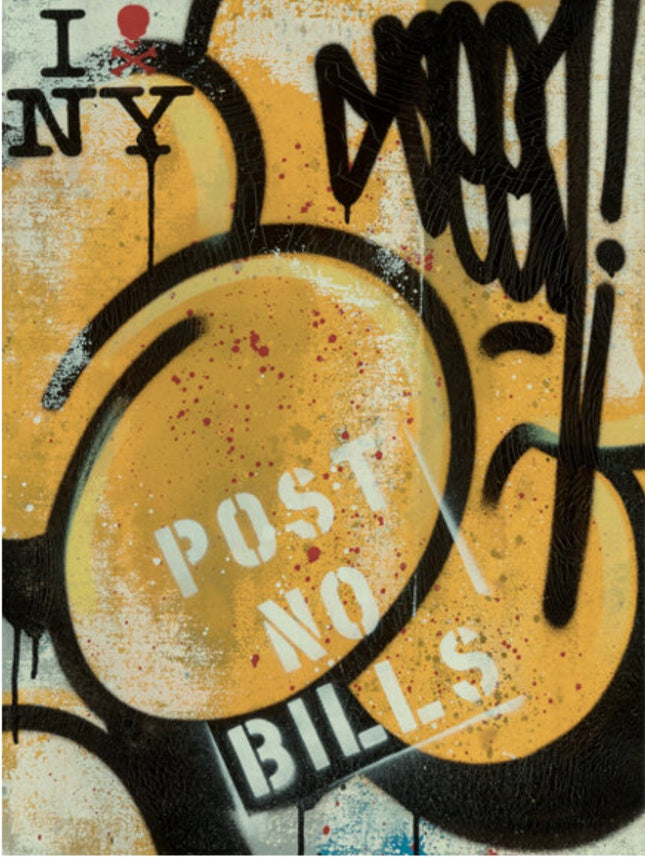
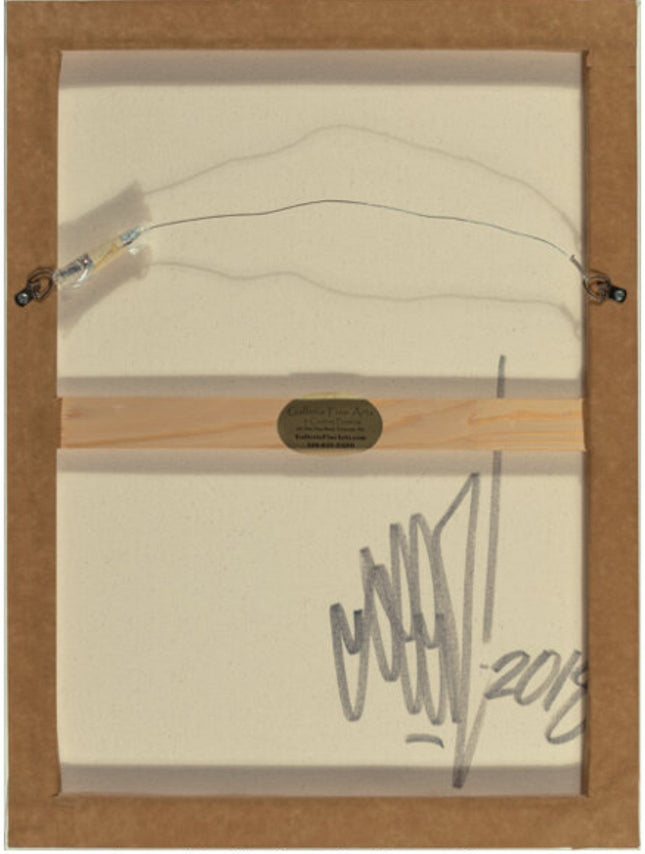
Seen UA Post No Bills- Untitled Stencil Original Graffiti Painting by Seen UA
Post No Bills- Untitled Original One of a Kind Spray Paint & Stencil Painting Artwork on Stretched Canvas by Popular Street Art Pop Culture Artist Seen UA. 2018 Signed Original Painting Size 18x24 Craquelure throughout. Unlined canvas.
$1,324.00
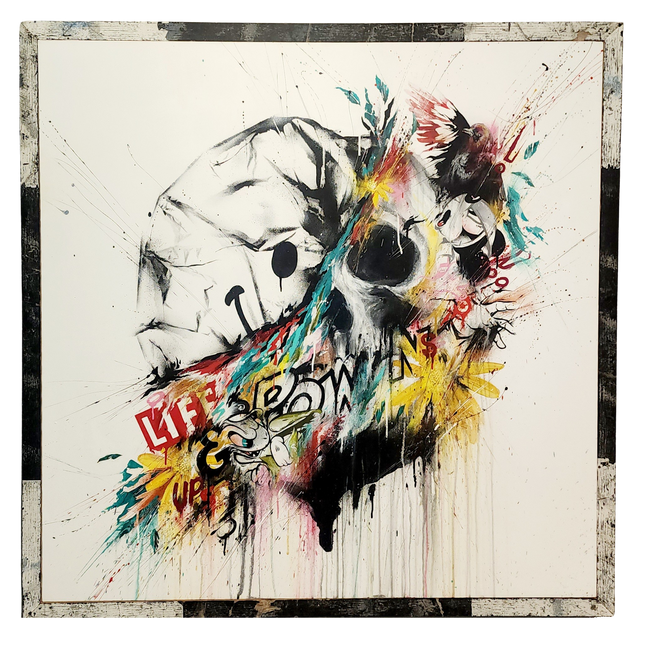
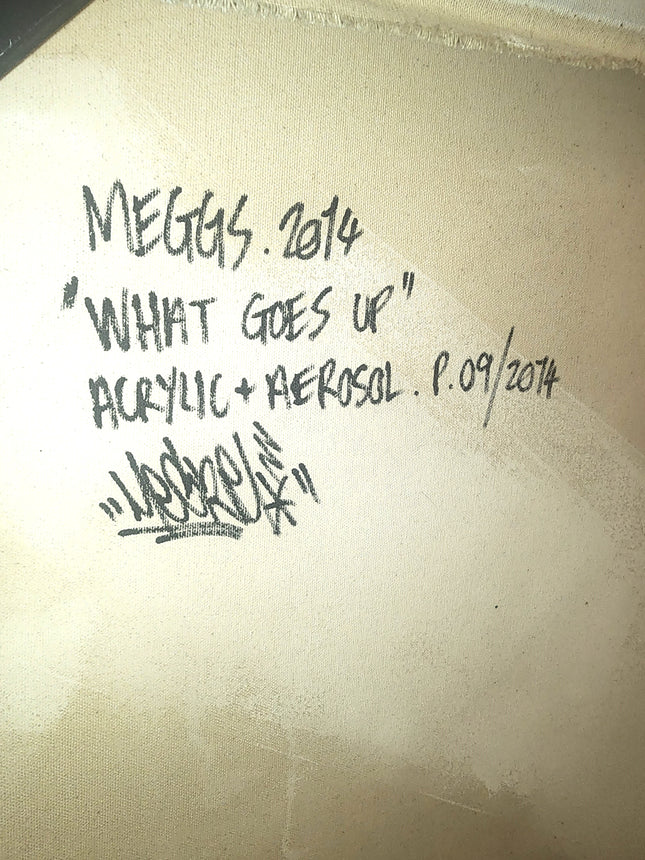
Meggs What Goes Up Original Spray Paint Acrylic Painting by Meggs
What Goes Up Original Spray Paint Acrylic Painting by Meggs One of a Kind Artwork on Canvas with Custom Reclaimed Wood Frame by Street Art Pop Artist. 2014 Signed Acrylic & Spray Paint Painting Original Canvas in Artist Hand Made Reclaimed Wood Frame Artwork Size 49x49. From Spoiled Rotten Show. Exploring the Dynamic Essence of Meggs' "What Goes Up" "What Goes Up" is an original acrylic and spray paint painting by the acclaimed street pop artist Meggs that encapsulates the dynamism and energy of his work. Created in 2014, this artwork reflects Meggs' signature style, which harmoniously blends street art's rawness with pop art's vividness. This one-of-a-kind artwork is a statement piece and a storytelling canvas that explores themes prevalent in Meggs' oeuvre, such as the constant struggle between opposing forces and the transient nature of success and failure. The painting measures 46x46 inches and is housed in a custom reclaimed wood frame handcrafted by the artist. Reclaimed wood adds an eco-conscious dimension to the artwork, reinforcing Meggs' interest in sustainability and the repurposing of materials. This choice of framing also accentuates the urban and gritty feel of the painting, resonating with the street art tradition of using found objects and spaces. Artistic Techniques and Visual Impact in "What Goes Up" Meggs employs acrylic and spray paint in "What Goes Up," showcasing his adeptness at using traditional and non-traditional media. The acrylic provides depth and texture, while the spray paint offers a sense of immediacy and spontaneity intrinsic to graffiti artwork. The painting is a cacophony of colors, bursting forth from a central point, suggesting an explosion of energy and creativity. The colors are not just randomly splashed across the canvas; they are meticulously layered to create a visual impact that is both chaotic and controlled. The artwork features a skull motif, a recurring element in Meggs' art, which often symbolizes the transient nature of human existence and the cyclical nature of life. However, in "What Goes Up," the skull is juxtaposed with vibrant colors and comic-style exclamations, which could be interpreted as a commentary on the superficiality of popular culture and the fleeting nature of fame and success. The skull seems to be disintegrating or exploding into an array of colors and shapes, a powerful visual metaphor for the inevitable downfall that follows a rise to the top. Cultural Commentary and the Essence of Street Pop Art The painting's title, "What Goes Up," hints at the adage "what goes up must come down," suggesting a narrative of ascent and descent. Meggs often infuses his Street Pop Art and graffiti Artwork with philosophical musings and critical observations of society. The work symbolizes the cyclical patterns of life and can be seen as a reflection of the transient nature of success or the hubris that often precedes a fall. The artist's use of text in the painting, rendered in a comic book style, adds a layer of communication with the viewer, inviting them to ponder the deeper meanings behind the vibrant facade. The piece is a testament to the artist's ability to navigate the space between gallery and street art, making it accessible to a diverse audience. The inclusivity of street art is evident in Meggs' work, where the public space becomes a canvas for dialogue, and the art becomes a part of the everyday urban landscape. "What Goes Up" is not just a visual spectacle but also a piece of cultural commentary, encapsulating the ethos of street art and its role in contemporary discourse. "What Goes Up" is a prime example of Meggs' impact on the field of street art and his contribution to the broader pop art movement. The painting manifests the artist's dedication to craft, concept, and commentary. Through the integration of various artistic techniques and the strategic use of reclaimed materials, Meggs has created an artwork that is both a visual feast and a conceptual powerhouse. The significance of Meggs' work lies in its ability to resonate with viewers on multiple levels. This work can be appreciated for its aesthetic qualities and ability to evoke emotion and provoke thought. As a piece of Street Pop Art and graffiti Artwork, "What Goes Up" embodies the spirit of this genre, which continues to push the boundaries of art and its place in society. It remains a poignant piece within Meggs' body of work and within the larger conversation of contemporary art.
$10,000.00
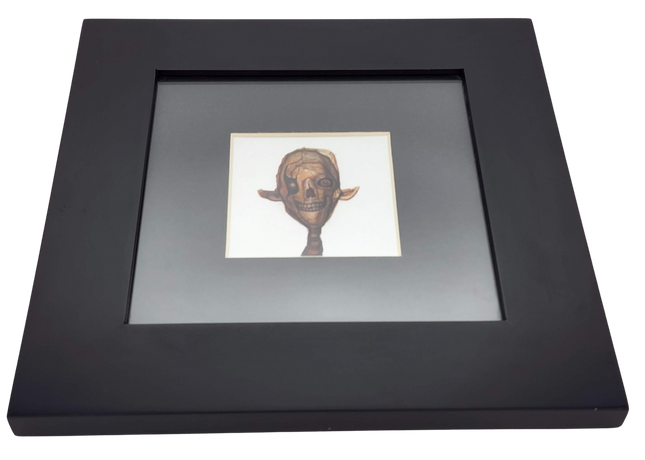
Naoto Hattori Goonie 037 Original Watercolor Painting by Naoto Hattori
Goonie 037 Original Watercolor Art Painting on Framed Fine Art Paper by Surreal Artist Naoto Hattori. 2013 Signed Original One-of-a-Kind Watercolor Painting Framed Artwork Frame Size 8.5x8.5 Image Size 3x3 Custom Framed & Matted By Artist. The Distinctive Fusion of Surrealism and Street Pop Art in Goonie 037 by Naoto Hattori Naoto Hattori's original watercolor painting, "Goonie 037," presents a compelling narrative within the spectrum of Street Pop Art & Graffiti Artwork despite its more traditional medium and surrealistic approach. Diverging from the typical urban landscapes and politicized messages of street art, Hattori encapsulates an enigmatic presence that resonates with the peculiar and profound characteristics that align with the whimsical and the bizarre. The small-scale image size of 3x3 inches, housed within an 8.5x8.5-inch frame, commands attention through its intimacy and intricacy, a testament to Hattori's meticulous craftsmanship. Crafted in 2013, this one-of-a-kind watercolor painting brings forth the imaginative realms Hattori is renowned for while also hinting at the essence of Street Pop Art through its unique presentation and the artist's choice to custom frame and matt the piece himself. This personal involvement in the presentation echoes the hands-on approach of street artists, who often control every aspect of their work, from conception to installation. The artwork's intricacy and bespoke framing suggest a dialogue with the viewer, an intimate exchange often sought after in street art. Hattori's "Goonie 037" does not explicitly borrow from the visual language of graffiti but instead infuses the personalized, often subversive spirit of graffiti art into a more surreal and fantastical realm. This piece, signed and validated by the artist, showcases his skill in rendering otherworldly subjects with a precision and depth that is palpably felt. Although the work is rooted in fine art traditions, its spirit of non-conformity and the surprise element inherent in its surreal subject resonates with the disruptive ethos of Street Pop Art & Graffiti Artwork. Naoto Hattori's Artistic Legacy and the Intersection with Urban Aesthetics While "Goonie 037" might at first glance seem distant from the raw vibrancy of street art, its singular nature aligns with the one-off pieces that adorn city walls, often never to be replicated or seen elsewhere. Hattori's decision to engage with watercolor—a medium often perceived as delicate and requires a systematic approach—parallels the precision street artists apply with their spray cans and stencils. The artwork's surreal character challenges the viewer's perception and invites interpretations as varied as the audience that encounters it, akin to the diverse viewership of Street Pop Art & Graffiti Artwork. The convergence of Naoto Hattori's work with the sensibilities of Street Pop Art & Graffiti Artwork lies in the shared ethos of both realms to evoke emotion, challenge norms, and captivate through visual storytelling. "Goonie 037," with its rich textures and profound depth, embodies a visual monologue that speaks to the onlooker on multiple levels. The artwork encourages a pause, a closer inspection, and a moment of reflection, much like street art that compels passersby to stop and ponder. In examining the legacy of Naoto Hattori and his creation "Goonie 037," one can see the threads that connect his work with the larger tapestry of Street Pop Art & Graffiti Artwork. His oeuvre reminds us that art cannot be confined to a single category or style but is a fluid and ever-evolving entity that draws from myriad influences and manifests in various forms. "Goonie 037" thus stands as a bridge between the worlds of surrealism and street art, embodying the transformative power of art to transcend boundaries and engage with viewers across diverse spectrums.
$651.00







